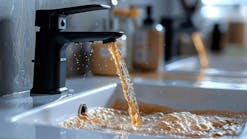To help schools, businesses, and other facilities save water in restrooms, the U.S. Environmental Protection Agency (EPA) has added a new category to its list of products that can earn the WaterSense label—flushometer-valve toilets, also known as water closets. Here, WQP Associate Editor Elisabeth Lisican discusses the new category with WaterSense Lead Engineer Stephanie Tanner.
Elisabeth Lisican: Please explain the new category that was recently added to the list of products that can earn the WaterSense label.
Stephanie Tanner: WaterSense has added flushometer-valve toilets to its family of labeled products. This includes flushometer-valve fixtures, including blowout- and siphonic-type fixtures, that receive liquid and solid waste and use water to convey waste through a trap seal into a gravity drainage system; single- and dual-flush flushometer valves that deliver water to toilet fixtures via a pressurized water supply line; and complete systems consisting of a specific flushometer valve and fixture that are sold together
as a combination. Retrofit devices, including flushometer-valve handles or other aftermarket retrofit systems, are not included in the scope of this specification.
The specification establishes a maximum flush volume of 1.28 gal per flush (gpf), which is 20% less than the 1.6-gpf volume associated with the federal standard. To ensure products’ savings, the 1.28-gpf maximum volume applies to both single-flush and dual-flush models. The specification also sets a minimum flush volume of 1 gpf to ensure adequate flow for the longer drain line that can be present in commercial buildings.
For products labeled and sold separately, EPA requires manufacturers to clearly indicate on product documentation that the fixture or flushometer valve should be used with a WaterSense labeled counterpart with a compatible flush volume to ensure that the entire system meets the requirements of this specification for water efficiency and performance.
Lisican: What prompted this new category to be added?
Tanner: WaterSense had already developed a specification for tank-type toilets that are used in residences and some commercial settings. We knew there would also be a great opportunity for water savings in commercial settings. There are an estimated 27 million flushometer-valve toilets in use throughout the U.S., more than one-quarter of which are older models with flush volumes exceeding the 1.6-gpf federal standard. We delayed the development of a specification because there were concerns about potential blockages that could result from reduced flows in the longer drain lines that are more prevalent in commercial buildings. The Plumbing Efficiency Research Coalition undertook studies over the past few years that provided the information we needed to ensure that we understood potential issues and could address them in our specification.
Lisican: What kinds of savings can be achieved by adding this new category?
Tanner: We estimate that replacing one old, inefficient model with a WaterSense model could save a business nearly 5,500 gal of water and $50 a year. At the building scale, the savings are obviously greater if the manager is replacing older, inefficient models with those that have the WaterSense label. For example, we estimate that a 10-story building with 1,000 occupants could save 1.2 million gal and $10,000 in water costs per year. Even targeting women’s restrooms alone could save 870,000 gal, since men’s restroom use will include use of flushing urinals, which are hopefully WaterSense labeled as well.
Lisican: How can manufacturers of toilet fixtures and flushometer valves earn and utilize this label?
Tanner: Manufacturers who are producing models to meet the WaterSense specification should first partner with the WaterSense program and then reach out to the certifying bodies [that] will evaluate the products as part of our third-party certification process. If their product passes, they will receive the label and begin to use it in on their product packaging and promote the availability of labeled products. Many states, local governments, water utilities, green building programs and facility managers are very interested in seeing the installation and/or replacement of older models with more water-efficient models. So, it will be important for any manufacturer with labeled products to get the word out that they have products available to help save water.
Download: Here


